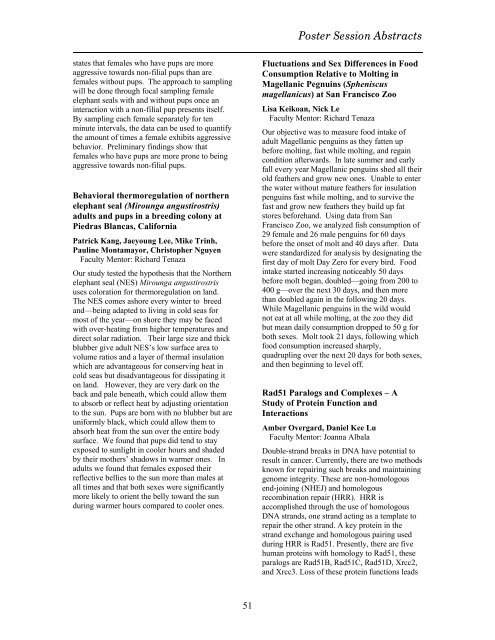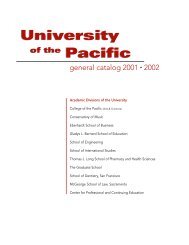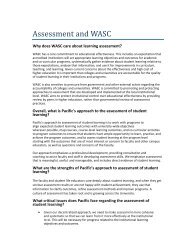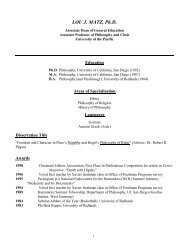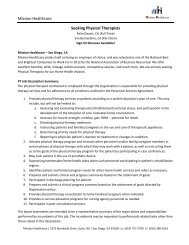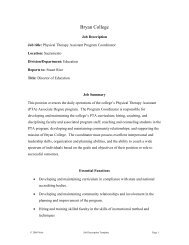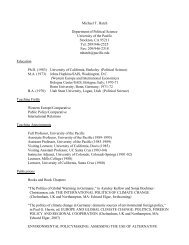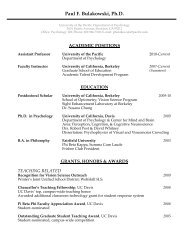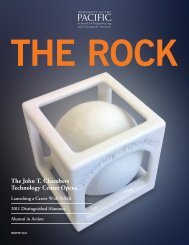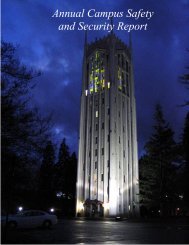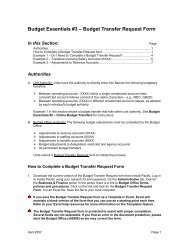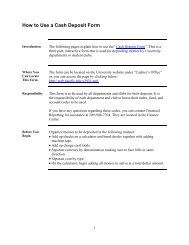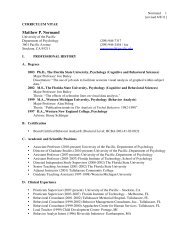purcc 2012 - University of the Pacific
purcc 2012 - University of the Pacific
purcc 2012 - University of the Pacific
Create successful ePaper yourself
Turn your PDF publications into a flip-book with our unique Google optimized e-Paper software.
Poster Session Abstracts<br />
states that females who have pups are more<br />
aggressive towards non-filial pups than are<br />
females without pups. The approach to sampling<br />
will be done through focal sampling female<br />
elephant seals with and without pups once an<br />
interaction with a non-filial pup presents itself.<br />
By sampling each female separately for ten<br />
minute intervals, <strong>the</strong> data can be used to quantify<br />
<strong>the</strong> amount <strong>of</strong> times a female exhibits aggressive<br />
behavior. Preliminary findings show that<br />
females who have pups are more prone to being<br />
aggressive towards non-filial pups.<br />
Behavioral <strong>the</strong>rmoregulation <strong>of</strong> nor<strong>the</strong>rn<br />
elephant seal (Mirounga angustirostris)<br />
adults and pups in a breeding colony at<br />
Piedras Blancas, California<br />
Patrick Kang, Jaeyoung Lee, Mike Trinh,<br />
Pauline Montamayor, Christopher Nguyen<br />
Faculty Mentor: Richard Tenaza<br />
Our study tested <strong>the</strong> hypo<strong>the</strong>sis that <strong>the</strong> Nor<strong>the</strong>rn<br />
elephant seal (NES) Mirounga angustirostris<br />
uses coloration for <strong>the</strong>rmoregulation on land.<br />
The NES comes ashore every winter to breed<br />
and—being adapted to living in cold seas for<br />
most <strong>of</strong> <strong>the</strong> year—on shore <strong>the</strong>y may be faced<br />
with over-heating from higher temperatures and<br />
direct solar radiation. Their large size and thick<br />
blubber give adult NES’s low surface area to<br />
volume ratios and a layer <strong>of</strong> <strong>the</strong>rmal insulation<br />
which are advantageous for conserving heat in<br />
cold seas but disadvantageous for dissipating it<br />
on land. However, <strong>the</strong>y are very dark on <strong>the</strong><br />
back and pale beneath, which could allow <strong>the</strong>m<br />
to absorb or reflect heat by adjusting orientation<br />
to <strong>the</strong> sun. Pups are born with no blubber but are<br />
uniformly black, which could allow <strong>the</strong>m to<br />
absorb heat from <strong>the</strong> sun over <strong>the</strong> entire body<br />
surface. We found that pups did tend to stay<br />
exposed to sunlight in cooler hours and shaded<br />
by <strong>the</strong>ir mo<strong>the</strong>rs’ shadows in warmer ones. In<br />
adults we found that females exposed <strong>the</strong>ir<br />
reflective bellies to <strong>the</strong> sun more than males at<br />
all times and that both sexes were significantly<br />
more likely to orient <strong>the</strong> belly toward <strong>the</strong> sun<br />
during warmer hours compared to cooler ones.<br />
Fluctuations and Sex Differences in Food<br />
Consumption Relative to Molting in<br />
Magellanic Pegnuins (Spheniscus<br />
magellanicus) at San Francisco Zoo<br />
Lisa Keikoan, Nick Le<br />
Faculty Mentor: Richard Tenaza<br />
Our objective was to measure food intake <strong>of</strong><br />
adult Magellanic penguins as <strong>the</strong>y fatten up<br />
before molting, fast while molting, and regain<br />
condition afterwards. In late summer and early<br />
fall every year Magellanic penguins shed all <strong>the</strong>ir<br />
old fea<strong>the</strong>rs and grow new ones. Unable to enter<br />
<strong>the</strong> water without mature fea<strong>the</strong>rs for insulation<br />
penguins fast while molting, and to survive <strong>the</strong><br />
fast and grow new fea<strong>the</strong>rs <strong>the</strong>y build up fat<br />
stores beforehand. Using data from San<br />
Francisco Zoo, we analyzed fish consumption <strong>of</strong><br />
29 female and 26 male penguins for 60 days<br />
before <strong>the</strong> onset <strong>of</strong> molt and 40 days after. Data<br />
were standardized for analysis by designating <strong>the</strong><br />
first day <strong>of</strong> molt Day Zero for every bird. Food<br />
intake started increasing noticeably 50 days<br />
before molt began, doubled—going from 200 to<br />
400 g—over <strong>the</strong> next 30 days, and <strong>the</strong>n more<br />
than doubled again in <strong>the</strong> following 20 days.<br />
While Magellanic penguins in <strong>the</strong> wild would<br />
not eat at all while molting, at <strong>the</strong> zoo <strong>the</strong>y did<br />
but mean daily consumption dropped to 50 g for<br />
both sexes. Molt took 21 days, following which<br />
food consumption increased sharply,<br />
quadrupling over <strong>the</strong> next 20 days for both sexes,<br />
and <strong>the</strong>n beginning to level <strong>of</strong>f.<br />
Rad51 Paralogs and Complexes – A<br />
Study <strong>of</strong> Protein Function and<br />
Interactions<br />
Amber Overgard, Daniel Kee Lu<br />
Faculty Mentor: Joanna Albala<br />
Double-strand breaks in DNA have potential to<br />
result in cancer. Currently, <strong>the</strong>re are two methods<br />
known for repairing such breaks and maintaining<br />
genome integrity. These are non-homologous<br />
end-joining (NHEJ) and homologous<br />
recombination repair (HRR). HRR is<br />
accomplished through <strong>the</strong> use <strong>of</strong> homologous<br />
DNA strands, one strand acting as a template to<br />
repair <strong>the</strong> o<strong>the</strong>r strand. A key protein in <strong>the</strong><br />
strand exchange and homologous pairing used<br />
during HRR is Rad51. Presently, <strong>the</strong>re are five<br />
human proteins with homology to Rad51, <strong>the</strong>se<br />
paralogs are Rad51B, Rad51C, Rad51D, Xrcc2,<br />
and Xrcc3. Loss <strong>of</strong> <strong>the</strong>se protein functions leads<br />
51


